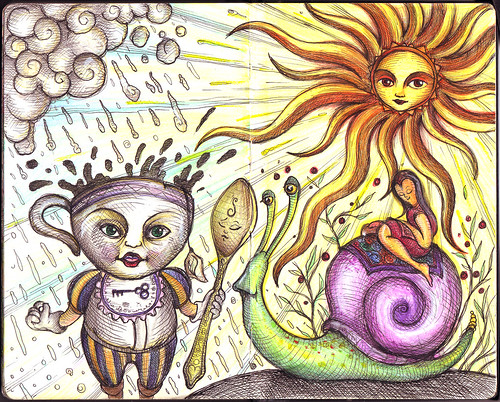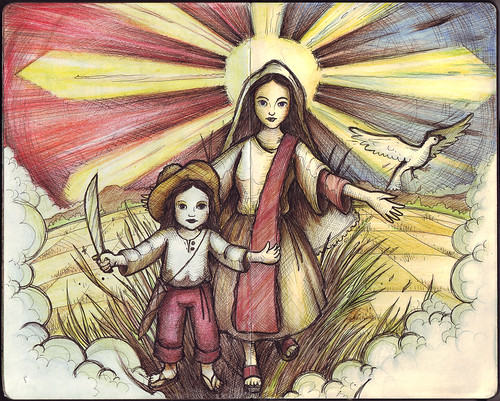Tuesday, June 26, 2012
Waking Up
"How can you prove whether at this moment we are sleeping, and all our thoughts are a dream; or whether we are awake, and talking to one another in the waking state?" Plato
Saturday, June 9, 2012
The Virgin of Balintawak
After reading Ambeth Ocampo's column at the Philippine Daily Inquirer entitled "Virgin of Balintawak", I suddenly remembered where I read or saw some images about the virgin before. I retrieved from my little library the book I bought to feed my private history curiosities, Ileto's "Pasyon and Revolution, Popular Movements in the Philippines, 1840-1920" and there it was, the virgin and the child drawn on the cover. I also remembered seeing this back when I was still in second year college when I visited the Philippine Independent Church near our school. I have always been fascinated by how the Katipuneros seem to intermingle local mythology, religious zealousness and nationalistic aspirations in their way of life. I've cited Bernardo Carpio before, and this is another example.
Here are some excerpts from Gregorio Aglipay's "Novenary of the Motherland" pertaining to the virgin:
“When he was still living, the journalist Aurelio Tolentino used to say that one night when Andres Bonifacio, Emilio Jacinto and other comrades were sleeping in the house of Sore in Balintawak, one of them saw in a dream a beautiful Mother dressed in the style of the farmers of Balintawak, leading a pretty child by the hand, dressed like a farmer with short red pants and holding a shiny bolo, crying Liberty! Liberty!
“The beautiful woman approached the one dreaming and said to him, ‘Be careful.’
“When the dreamer woke, he told his comrades what he had dreamed, saying that the Mother and Child had the face of Europeans though dressed like Filipinos.
“Because of this, they did not follow their plan to return to Manila for their regular work but decided to wait in Balintawak awhile. It was not long before news came that the Guardia Civil Veterana had raided the press of the Diario de Manila and captured a number of Katipuneros and their papers.
“Because of this dream, Aurelio Tolentino adds, ‘the first soldiers of the Katipunan wore red trousers.’
“But for this dream, Andres Bonifacio and his staff would have been captured and we would still not be free even now.
“The Mother of Balintawak reminds you constantly of your sacred and inescapable duty to make every effort possible to obtain our longed-for independence; and she is the sacred image of our Country.’ The voice of the people will constantly resound from our pulpits, reminding you of the great teachings of Rizal, Mabini, Bonifacio and other Filipinos, and these teachings of our greatest compatriots will form the special seal of our National Church.”
Further on: “The Mother of Balintawak symbolizes our Country, and the Katipunan child expresses the Filipino people, the rising generation which longs for independence, and both figures consistently reminds us of the tremendous sacrifices of the liberators of our Country and of our sacred and inescapable duty to follow them, also making all possible sacrifices on our own part to achieve our independence.”
And: “In this image of the Motherland, we symbolize all our natural drive for national independence. The Virgin-Mother is the Country, for the Country is the only mother that can truly be called Virgin, Virgin as it is of all lust. The Katipunero child represents the People, eager for their liberty, and their spokesmen, prophets and evangelists are the great Filipino teachers: Rizal, Mabini, Bonifacio, and our other countrymen whose modern sapient teachings will form the best national Gospel.”
Subscribe to:
Posts (Atom)





